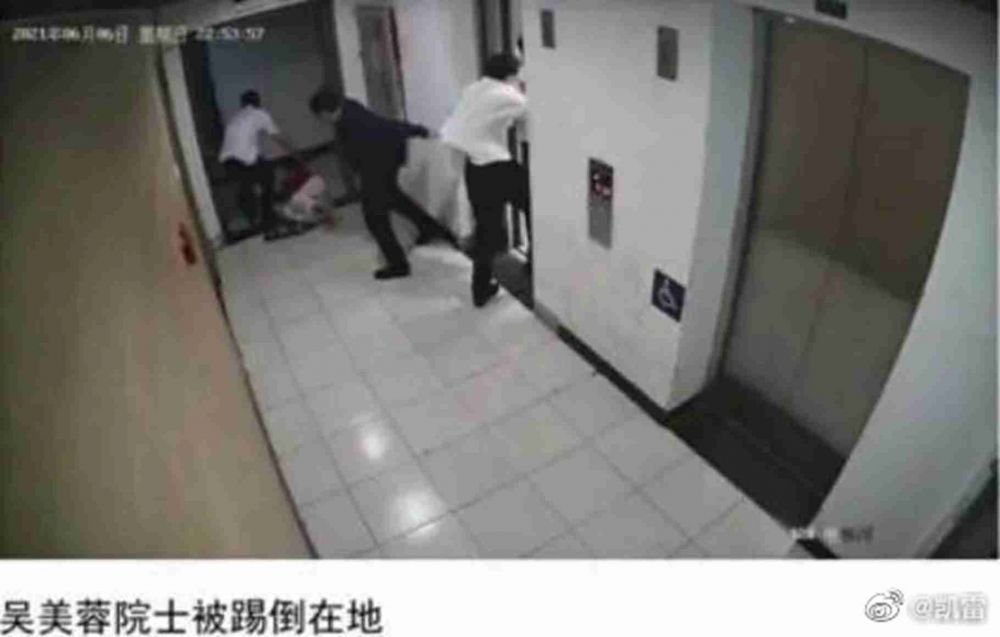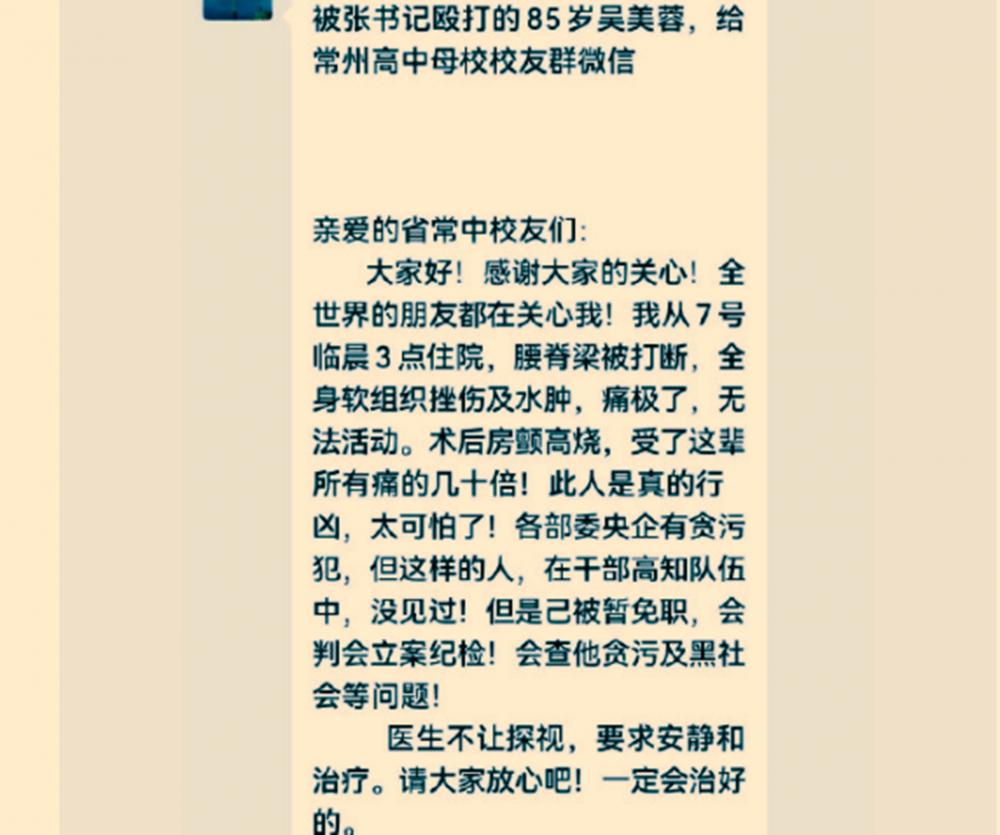中國航天投資控股有限公司黨委書記、董事長張陶打傷兩院士事件持續發酵,被打傷的吳美蓉院士寫給母校的信件曝光。
北京警方7月5日發布的通報顯示,事件發生於6月6日19時許,張陶與王晉年、吳美蓉在餐廳共同就餐,期間張陶、王晉年酒後發生口角。三人於22時40分在某小區再次發生口角,張陶多次踢踹毆打王晉年。期間,吳美蓉在勸阻過程中因被張陶拉拽、碰撞,兩次倒地。至23時18許,三人才被勸開,傷者後被送醫。

網絡公開的吳美蓉寫給校友的回複信顯示,張陶在酒席間就已動手毆打王晉年,跟到小區後再次動手,吳美蓉被打兩次。
而事件起因是張陶要求吳美蓉和王晉年幫助他當院士,王晉年有所推辭遭致。

吳美蓉寫給校友的信

吳美蓉透露事件細節
她在這封寫給常州中學校友的信中寫道:“此人要求我和王晉年幫助他當院士(他已有人推薦,正在選舉過程中。不是要我們推薦,也不是落選。選舉至6月底才結束。)我對此人說會努力幫助都是好話啊!但王所說剛認識要了解了解,他就動手打王,還跟到家打人,打了一個多小時,中間打了我兩次,網上不清楚公安機關的從各個攝像頭看第一次用二手及手臂從右側使勁把我拋出四、五米遠!完全可能致命!我自動讓頭部晚著地!第二次他用手及手臂把我手拉住快捷壓下立即脊骨斷了!”
吳美蓉稱,“(張陶打人)極其凶殘,我們被打二人雖承受肉體上的痛苦,但為國為民找出毒瘤或者一串壞蛋也是值得!殘忍極了與黑社會一樣!他打我的視頻很可怕警察給我看的,網上的隻是一個攝像頭遠不清楚。他還造謠更不像話!謝謝關心!這二天常州辦事處天天來,還派來了照顧我的人(外人不敢用怕壞人搞暗殺!)醫院特重視保安!謝謝大家!這二天除非洲滿世界的朋友都在為我難受,要嚴懲凶手!祝福我早日康複!可轉發大家!”
另外,吳美蓉要求嚴懲凶手。不過,尚無法證實此信件是否為其本人所寫。
資料顯示,張陶1964年生,曾任中國航天科技集團公司計劃經營部經濟技術合作貿易處長,香港航天科技國際集團有限公司規劃開發部總經理、執行董事,中國航天科技集團公司經營投資部副部長等職。
7月5日,張陶已被警方刑事拘留。
來自病毒學,基因學以及計算機科學領域的31位國際知名學者6月28日發表聯署呼籲,要求對新冠病毒的來源展開深入的調查,類似的呼籲書雖然並非首次,但是,今次呼籲的獨到之處是提出了一個B計劃,即使中國繼續拒絕合作,也可能對病毒的來源展開徹底的調查。
公開信的簽署者認為在中國之外也有許多重要的信息可以幫助追溯病毒的真正來源,他們明確呼籲與武漢實驗室有合作關係的實驗室與科研單位公布他們所擁有的信息,尤其是那些研究冠狀病毒的機構,這些機構包括美國的健康聯盟協會(EcoHealth Alliance)以及歐洲的一些研究機構,尤其是法國的巴士德學院,法國國家健康與醫學研究院(INSERM)以及法國裏昂的梅裏埃基金會,還包括一些為武漢實驗室提供科研經費的基金會。
法國巴黎大學,雅克莫諾學院(Institut Jacques Monod - CNRS UMR7592 - Université de Paris )的基因進化研究專家Virginie Courtier女士是牽頭發表上述呼籲書的學者之一,此前她已經多次簽署了類似的呼籲書,她在接受法廣中文部采訪時詳細解釋了她之所以幾次三番簽署類似的公開信呼籲追溯病毒來源以及她為何從一開始就對病毒的來源產生懷疑的原因所在。她在訪談中特別對武漢實驗室公布的最接近新冠病毒的RaTG13病毒提出了種種疑問。她還表示自己在6月11日直接致函武漢實驗室的負責人石正麗女士,但卻沒有收到到石正麗的任何回音。
以下是法廣6月29日對Virginie Courtier女士的采訪文字內容:
法廣:Virginie Courtier女士,非常感謝您接受法廣中文部的采訪,首先,您並不是首次參與發表呼籲追溯病毒來源的公開信,您為什麽要如此堅持?
Virginie Courtier: 新冠病毒殃及及全世界各國的民眾,我們誰都不希望類似的疫情再度發生,所以我認為必須徹底尋找出病毒的根源,以避免類似的疫情再度發生,倘若今後發生類似的疫情時就能夠知道如何應對。所以對我來說,這是一個十分重要的問題,尤其是今天疫情仍然沒有結束,繼續在產生著十分嚴重的後果。我感到十分震驚的是國際社會對造成如此嚴重後果的病毒居然沒有做出更加深入的調查。我認為一部分科研工作者可以從事應對疫情,研製疫苗,尋找有效的療藥,另一部分則可以致力於尋找病毒的根源,避免重蹈覆轍,我認為這兩者並不矛盾。
法廣:我們都注意到新冠病毒正在不斷的突變,這一點同病毒的來源是否有關?從病毒突變的速度上是否能夠推測出病毒是正常自然產生還是經過實驗室改造?
Virginie Courtier:這不能說明什麽,我知道媒體高度關注病毒的突變,但其實流感病毒的突變也十分迅速,這關鍵取決於病毒的屬性。隨著感染新冠病毒的人數的增長,病毒變異的機會也不斷增加。不過,我們大可不必對此過於擔憂,因為到目前為止,許多疫苗依然帶有一定的抵抗作用。
法廣: 我們現在說的變異病毒,對您來說,最早的病毒是來自武漢嗎?因為中國官方依然在強調雖然疫情首先爆發在武漢,但是,這並不意味著病毒就一定來自武漢。您認為有這種可能嗎?
Virginie Courtier:就目前而言,我們對疫情最早的情況尚沒有定論,我們已知的是,2019年年底,疫情在武漢爆發,而對之前的情況並不了解,我們在意大利,在西班牙,很可能在法國,也找到一些病毒的可能的痕跡。但是,我們尚沒有對這些病毒的樣本做基因測試,因為血樣中出現病毒抗體並不足以說明問題,因為有時候病毒之間會出現交叉現象,但是,倘若我們能夠對出現在2019年年底的病毒的基因樣本作出編譯,編譯出他們的基因序列並且加以分析,我們應該可以對病毒的起源獲得進一步的了解。
法廣:您說的這些病毒樣本是在中國嗎?
Virginie Courtier:不僅僅在中國,在歐美各國的醫院都有儲藏,我們知道,法國和意大利已經開始編譯這些病毒的基因序列,但是,別的國家的情況就不是很了解。至於中國,這是一個很大的問題。我們無法獲得在疫情爆發初期的病人的樣本。因為很可能中國的醫院中儲藏著疫情爆發初期留下的尚未被分析研究的樣本。即使世衛組織也未能獲得上述樣本。之所以要編譯最初的病毒的基因樣本,是因為這樣才能夠逐漸地拚湊出病毒最早出現時的基因序列,就目前所知,最早病毒似乎是同一個病毒感染了一大波人,所以,追溯病毒最早出現的痕跡可以幫助了解病毒從何時開始突變,以及在什麽樣的情況下發生突變,也可以幫助了解病毒究竟在何地首次出現。
法廣:如果我沒有理解錯的話,對您來說,中國官方所謂雖然疫情在武漢爆發,但是病毒並不一定最早出現在武漢的說法並不是毫無理由?
Virginie Courtier:怎麽說呢,新冠病毒畢竟與蝙蝠的病毒很相近,而這些蝙蝠主要生存於東南亞,尤其在中國的南方。四十年前,這些冠狀病毒存符於蝙蝠的身上。之後,究竟發生了什麽讓這些病毒開始感染人類。從邏輯推理的角度,生活在亞洲的蝙蝠身上的冠狀病毒感染了當地的民眾,之後爆發疫情,應該是最簡單的傳播方式。當然,也可以想象,病毒可能途經另一個國家再感染中國,這種可能性明顯較低,因為它一定會留下痕跡。當然,在真相尚未大白之前,在仔細分析研究所有的數據之前,我們當然不可能百分之百地排除其中任何一種可能。正如我們不能夠肯定病毒究竟是來自自然界還是實驗室。
法廣: 這正是我要向您提出地另一大問題,我們注意到在法國協助武漢建設P4實驗室之後,中國官媒對此的反應,認為中國從此可以在生物病毒研究領域與美國抗衡,中國軍方也渲染該實驗室所能夠帶來的無窮的可能性。一開始被譴責為是陰謀論的實驗室泄露論,今天獲得了越來越多的專家的支持,在您看來,實驗室泄露的可能性究竟有多大?
Virginie Courtier:其實從疫情爆發的第一時間,我就懷疑這一病毒是否是自然來源。今天對我來說這依然是一個問題。因為我們必須承認,我們並沒有確鑿的證據。當然,我們懷疑的理由是首先是地理因素,因為疫情首先在武漢爆發,而武漢實驗室就在當地,而且,實驗室研究的薩斯病毒正好與新冠病毒是同一類病毒。另一大理由,對我來說是最為重要的,那就是中國方麵對外隱瞞大量的重要信息,當然,中方或許有他自己的理由,我們在不了解原因的前提下加以譴責或許對他們來說很不公平。所以,對我來說,重要的是必須繼續加以追蹤,直到找到病毒的真正來源。
法廣:對,中國官媒往往以中國主權為由拒絕對外提供信息,拒絕接受世衛組織,美國或者別的國家提出的要求。不過,麵對已經造成數百萬人死亡的大瘟疫,國家主權或者民族自尊等等理由似乎都不足以解釋中國官方的立場。記得我去年采訪了一位來自中國的病毒學家,她認為新冠病毒一定來自實驗室,她的理由是病毒基因中有可以感染人類的S蛋白,她認為這一蛋白的存在顯示這是一個人為加工的病毒,因為在正常自然基因演變的情況下,病毒基因不可能在這麽短的時間內出現這個蛋白。對她來說,這一點是十分明顯的。不過,令人驚訝的是,法國的病毒學家們似乎對此並不感到驚訝,您怎麽看?
Virginie Courtier:這是她個人的觀點,或許對她來說十分明顯。其實,從客觀的角度來看,這並不是不可能的。之前研究者在創造新的病毒時,往往會把已經存在的病毒的基因組加在一起,而新冠病毒的基因序列中含有的序列是前所未有的,這也是最早駁斥病毒來自實驗室的人所提出的最主要的依據,不過,今天這一依據已經失效了,因為我們今天知道武漢實驗室正在研究與新冠病毒相接近的病毒。反對實驗室泄露論者的另一大依據是人造病毒一般都帶有分子切割的痕跡,而新冠病毒的基因序列上卻並沒有任何痕跡。當然,支持病毒來自實驗室的人強調病毒特別容易感染人類,似乎是專門為人類所設,這一點我認為並不是依據,因為肆虐全球的大流行病往往是幾十年才發生一次,造成此一災難的病毒當然不是一般的病毒。所以,可以想象是一係列的因素的連環作用導致了今天的後果。當然,新冠病毒身上帶有一個酶切入點,學界都知道對冠狀病毒加上此一切入點就可以使它更容易傳染。不過,新冠病毒上的這一酶切入點並不是研究者一般使用的方式。所以,病毒是自然演變的結果的可能性依然存在。這就是為什麽我們必須進行更加深入的研究。
法廣:當石正麗在2020年2月對外公布與新冠病毒最接近的RaTG13病毒的基因序列時您感到驚訝嗎?您怎麽理解一位研究者在發現了一個重要的病毒之後等待幾年之後才公布?
Virginie Courtier:我對這一點倒並不感到驚訝,因為發表一篇學術研究文章需要時間。不過,令我感到驚訝的是,RaTG13病毒的樣本沒有留下底稿。武漢實驗室在一篇學術文章中聲稱所有病毒樣本都已經用完,沒有樣本可以對基因編譯做核實。這一點使我感到十分奇怪,因為一般做研究的都會留下一些樣本。另外,還有一點也十分令人驚異,因為RaTG13病毒曾經以另一個名字RA4991出現在2019年6月的一篇博士論文中。為什麽同一個病毒會有兩個名稱?為什麽她在公布RaTG13病毒時沒有提到之前已經出現的病毒?
法廣:您今天對這些問題找到了可能的答案嗎?還是至今都無法理解?
Virginie Courtier:我實在無法理解,幾周前我曾經寫信給石正麗,向她提出了一係列的問題,但是,我至今沒有收到任何回答。當然,我也明白,她目前應該沒有任何自由。
法廣:是的,她的任何公開言論都應該受到嚴格的控製。您認識她本人嗎?因為她曾經在法國南方的蒙彼利埃大學就學,或許你們曾經有機會相遇。
Virginie Courtier:沒有,我研究的是基因進化課題,從事了二十年對蒼蠅的研究,隻是在新冠疫情爆發之後,才開始研究冠狀病毒。
法廣: 我曾經采訪過一位華裔的病毒學家,她認為RaTG13病毒很可能是一個人為編造的病毒。她說其實編造一個病毒的基因序列隻需要一周的時間,是一件很容易的事。當時,我認為這種想法或許有些異想天開,所以並沒有將此一訪問內容公開,不過,今天看來,人為編造基因序列的說法,那至少可以解釋您剛才所說的武漢實驗室不能夠提供的病毒樣本的原因。您認為這種可能性存在嗎?
Virginie Courtier:她認為這一病毒的基因序列完全是人為編造的!這是我從未想到的可能性。因為作為生物學家,這完全超出了我們的想象。不過,從技術層麵來講,這是完全有可能的,隻要坐在計算機前,就可以人為地編造出一個病毒的基因序列。其實,Drastic調查組的人從一開始就懷疑RaTG13病毒的真實性,因為我們缺乏與病毒相關的許多信息。比如說,一開始的時候,病毒的基因序列上最前麵的15個核苷酸(nucleotide)並沒有被公布,石正麗當初在回答科學雜誌的提問時說,缺乏基因樣本,因此未能編譯出最前麵的15個核苷酸(nucleotide)的基因序列。所以在最初公布的RatG13病毒的基因序列中並沒有這一部分的序列。但是,之後,不知道是由於什麽原因,這15個 核苷酸的基因序列出現了,而且同新冠病毒的序列完全一模一樣。這一切都讓我們感到十分費解。我和幾位同事羅列了一係列的問題發給了石正麗,因為隻有她知道這些問題的答案。
法廣:您其實從又開始就懷疑新冠病毒的自然來源的可信度,您為什麽會有這樣疑問呢?
Virginie Courtier:我從一開始就懷疑這一病毒的來源,但是,我最讓我覺得詭異的是為什麽許多重要的消息都沒有對外公布。比如說,新冠病毒的S蛋白酶的切入點,這些信息武漢病毒實驗室很可能早就知道,為什麽不對外公布?而且他們在公布的消息中刻意保留了有關切入點的消息。此外,新冠病毒與雲南的蝙蝠洞以及之前2012年出現的肺炎之間究竟有些什麽樣的關聯。所以,這一切,對我來說,我之所以對病毒的來源產生懷疑主要由於與新冠病毒產生有關的重要的消息,倒不是對病毒的基因序列或者別的有所懷疑。但是,我在這裏要指出的是對病毒基因序列的完整的深入的分析尚沒有完成,我期待能夠與我的同事們完成這一工作。
疑問焦點:RaTG13病毒
法廣:圍繞RaTG13病毒確實是疑團重重,許多專家都認為這一病毒集中了許多重要的疑點,您也這麽認為嗎?您覺得有關RatG13病毒的最大的疑問是什麽?
Virginie Courtier:對,我同意。這個病毒確實有許多重大的疑點;首先石正麗為何在首次在自然雜誌公布此一病毒時沒有提到之前已知的RA4991;其次,這一病毒的基因序列究竟是如何獲得的?為什麽我們不能夠獲得編譯前15個核苷酸的樣本?另外,他們為什麽會沒有留下病毒的樣本以便核實基因編譯程序? 如果我們仔細觀察 RaTG13的基因序列的話,裏麵並沒有許多細菌的數據。而一般而言,一個來自蝙蝠糞便的病毒的基因序列中應該有許多細菌的序列組。所以,這也是十分奇怪的。相反,我們在序列中找到了許多人類基因的序列。最後,RaTG13作為來自蝙蝠的病毒,到目前為止,尚沒有實驗室對 RaTG13病毒進行重組,但已經有人將其中的S蛋白重新組合,結果發現,S蛋白很難被蝙蝠的受體所接受,而它應該是一個來自蝙蝠身上的病毒。所以這一切都十分奇怪。
法廣:其實您所提出的上述疑問應該是一些客觀的從一開始就浮現的疑問,但是,我們注意到病毒學界公開提出上述疑問卻隻不過是在去年夏天,而且,許多知名的研究機構今天依然保持沉默,您對此怎麽理解?
Virginie Courtier:國際上許多研究機構同武漢實驗室合作過,對曾經信任的同事公開提出懷疑這並不是一件容易的事情,尤其是在實驗室泄露論尚且缺乏證據的背景下。
法廣:在疫情爆發的初期,英國著名的《柳葉刀》雜誌以及《自然》雜誌隨即先後發表文章,徹底排除實驗室泄露的可能性,並且將類似的懷疑推測定性為是陰謀論,導致類似的評論嘎然而止。我們有許多人當時都感到十分費解,因為實驗室泄露的現象雖然並不是每天都發生,但也時有發生,科學家可以擔保自己的實驗室沒有發生過,但又如何為幾千公裏之外的實驗室做擔保!今天,《柳葉刀》雜誌撤銷了美國衛生健康聯盟協會的主席Peter Daszak作為新冠病毒研究委員會的成員,您對此有何評論?
Virginie Courtier:對,《柳葉刀》認為Peter Daszak的工作帶有利益衝突性質,但是,卻並沒有對其他同樣有利益衝突嫌疑的人采取措施。當然,人們不要因此而以為科學界也是漆黑一團,《自然》雜誌最新發表的Jesse Bloom的最新發現的文章很有價值!
法廣:最後,您一定同許多對病毒溯源感興趣的人一樣注意到Peter Daszak在武漢疫情爆發之前不久在新加坡的一次學術討論會上曾經作出的有關冠狀病毒研究的言論,您對此有何看法?
Virginie Courtier:一般而言,我對他所作出的言論都持有保留,比如說,關於RaTG13,他說病毒在冷藏箱內儲存著,實驗室在疫情爆發時才將病毒的基因序列編譯出來,而今天武漢實驗室說,病毒基因序列早在2018年就已經完成。
法廣:非常感謝您接受法廣的專訪!
附件: Virginie Courtier6月11日寫給石正麗的電子郵件
法國基因進化研究學者Virginie Courtier 6月11日寫給石正麗的郵件
From: COURTIER Virginie
Sent: Friday, June 11, 2021 2:28 PM
To: zlshi@wh.iov.cn
Subject: questions around SARS-CoV-2
Dear Pr. Shi Zheng-Li,
These ongoing times are probably putting a lot of pressure on you and I imagine that the situation must be very difficult in the present context. I sincerely hope that you can cope with it well. As shown by the recent Science letter, many people in the scientific community are currently not satisfied with the conclusions of the WHO-China joint report and are asking for a more thorough investigation in order to unravel how SARS-CoV-2 spread into the human population. To try to put an end to the discussions about a possible lab origin of the virus, I think that it would be important to clarify the few elements below. Maybe you could help in this process.
In April 2012, after clearing bat guano in an abandoned mine in Mojiang (Yunnan), six men contracted severe pneumonia with COVID-19-like symptoms. All were sent to Kunming hospital where three eventually died. Unspecified samples from these patients were sent to different labs including the Wuhan Institute of Virology (WIV) in 2012. You recently announced that the WIV tested the serum samples again.Why were these six miners sent to clean guano in the mine in April 2012? Who hired them and sent them all to the same Kunming hospital?Why were these lethal pneumonia cases not mentioned in any scientific research article from the WIV, except the Nature’s Addendum from last November?What samples were taken from these six patients and sent to the WIV? Are any of these samples still available for independent analysis?Were any SARS-like coronaviruses isolated from the patient samples or were any RdRP or spike sequence obtained by RT-PCR?Is it possible to provide to the WHO serum samples from the three surviving miners in order to better understand in which condition these miners fell sick and what their exact pathology was?
2 You stated that Wuhan Institute of Virology virus databases were taken offline during the pandemic. However the key bat virus database was taken offline in September 2019, three months before the official date of outbreak started.Can you provide further details on why the database was shut down?Can all the databases, in their state as of September 2019, be shared with selected expert scientists?Do you have any information concerning the reasons why the scientific paper describing the key database (digital object identifier: 10.11922/csdata.2019.0018.zh) was taken offline from the corresponding Chinese journal website “China Science Data” mid-2020?Did you know that even the full website of “China Science Data”, where the database is described, became inaccessible in March-April 2021?
3。A bat coronavirus sampled in the Mojiang mine in 2013 (‘RaTG13’) is a virus most closely-related to SARS-CoV-2. In your interview with Science in July 2020, you said that “Ra4991” was renamed to “RaTG13”, the virus was not isolated, and that there is “no more sample”, so no further sequencing is possible. Unfortunately, based on the raw data provided, it has not been possible to assemble the RaTG13 genome sequence.How was the RaTG13 genome sequence assembled and how was the 5’ end sequence determined?Was “Ra4991” renamed to “RaTG13” for your article, as the Addendum seems to indicate, or are these 2 viruses divergent in some regions such as the spike protein ?When was the RaTG13 sample fully depleted?Why are a few of the RaTG13 amplicons dated as of June 2017 and named “7896”, which is the name of another closely related virus collected in the same mine?As the row data contains low levels of bacterial sequences, was RaTG13 sampled from bronchoalveolar lavage fluid or from bat feces?Given that RaTG13 shows weak binding to bat receptor ACE-2 and binds only to one of the ACE2 orthologs of Rhinolophus affinis, is RaTG13 the true whole genome sequence of the sample BtCoV/4991 collected in 2013 by the WIV?Did the WIV or any other laboratory ever attempt to recreate RaTG13 or any other coronaviruses by assembling them from synthetic gene sequences?
4。A striking feature of the SARS-CoV-2 genome is the presence of the furin cleavage site. This site was noted as a “cleavage site” in your January 2020 publication.Why was this so-called “furin cleavage site,” clearly an important and novel feature of the SARS-CoV-2 virus, not mentioned in your February 2020 Nature publication?
5.You acknowledged isolating three strains of live SARS-related coronaviruses, but based on the WIV naming convention for their live viruses isolates it appears that the WIV did not disclose two potential isolates, WIV6 (not WIV06) and WIV15, as these names are not mentioned in the literature.Do these isolates exist? If not, what is the explanation for why these isolate names were skipped in the series?
6.Chinese authorities have stated that all staff at Wuhan labs tested negative for SARS-CoV-2 antibodies.How many people were tested, in which Wuhan labs, on which days, and as part of which teams or services within these labs?Were any of these serum samples retained?Are independent international investigators able to retest the samples of the lab staff to confirm the results?
7.You previously wrote that: ‘Recently we tested the sera from all staff and students in the lab and nobody is infected by either bat SARSr-CoV or SARS-CoV-2. To date, there is "zero infection" of all staff and students in our institute ’. This statement is statistically unlikely (roughly less than one chance in a billion) given that there are more than 590 staff and students at the WIV and about 4.4% of the Wuhan urban population tested positive at around that time. Even if only 85 people were tested, the chance of no positive test would still be less than 4%.How can this unexpected observation be explained?Is it possible to have more information on the “one or two” WIV’s workers that fell ill in late 2019, as evoked by a member of the WHO-China joint mission?
8.Recently, you published a preprint presenting the 8 coronaviruses that were mentioned in Nature’s Addendum, in November 2020.The preprint indicates that these 8 new coronaviruses, including RaTG15, are constituting a novel lineage of SARSr-CoV from bats: "we report the identification of a novel lineage of SARSr-CoVs, including RaTG15 and seven other viruses, form bats”. When did exactly this identification take place?Do you confirm that the lineage called “lineage 4” in a phylogenetic tree (Figure 3.1) in the MS thesis by Yu Ping, "Geographic Evolution of Bat SARS-related Coronaviruses" (June, 2019), is the same lineage as that of the 8 new coronaviruses?The preprint mentions that these 8 viruses have been collected in “the same location where we found RaTG13 in 2015”. Why is the 2012 Mojiang mine’s outbreak that occurred at the same location not mentioned, which is important information to understand the context of your research?The preprint claims that none of the known viruses in bat SARSr-CoV-2 lineage or the novel lineage discovered so far use human ACE2 efficiently compared to SARSr-CoV-2 from pangolin or some of the SARSr-CoV-1 lineage: "We show that none of the known viruses in bat SARSr-CoV-2 lineage or the novel lineage discovered so far use human ACE2 efficiently compared to SARSr-CoV-2 from pangolin or some of the SARSr-CoV-1 lineage viruses." To support this statement, is it possible to share the complete list of unpublished viruses that are present in your institute, as well as the raw data and the experimentation records related to them?Are these 8 new viruses still kept in your institute, in what condition, and if they are physically available can they be made available to other researchers?Can you clarify whether the Bat Ra ACE2 sequence MT394204 used in the pre-print comes from the same Mojiang mine?How can you explain that the eight viruses are almost identical? How can you explain that each sequence was found only once along the 7 visits to the mine? Doesn’t it contradict your findings of a “rich gene pool” in the longitudinal study in the caves of Jinning? Did you retest all the 1,322 samples?Can you provide the raw sequencing data of the 8 viruses?Why do the 8 virus sequences display a few nucleotide changes in their RdRp sequences compared to the previous versions that were submitted to NCBI Genbank for the publication of the Latinne et al. paper? Can you explain the methods employed then and now?There is some confusion in the nomenclature of these viruses: in the slide of 2 different presentations from your lab, they were labeled Ra or Rs. Can you confirm the bat species infected with such viruses? Isn’t it surprising that RaTG15 is found in one bat species while the extremely close viruses are from another bat species? Could there be an issue regarding the bat species assignment based on COI sequence?
With my sincere and warmest regards,
Virginie
Virginie Courtier-Orgogozo
Institut Jacques Monod - CNRS UMR7592 - Université Paris Diderot
Bâtiment Buffon - 4e étage - 420B
15 rue Hélène Brion
75013 Paris
France
tél : (33) 1 57 27 80 43
fax : (33) 1 57 27 80 87
https://virginiecourtier.wordpress.com
@Biol4Ever








![[Pics] Film Roles That Ruined These Actors' Careers [Pics] Film Roles That Ruined These Actors' Careers](https://images.outbrainimg.com/transform/v3/eyJpdSI6IjNiYTRlZGY1MDJiYWUyZmY4NmEyNWY4ZGYyMzNjYmFhNTI2NjdhZDg5OWJkZjNiZGRmZmIxYWVkMjRiYTFiYTIiLCJ3IjoyNDAsImgiOjE2MCwiZCI6MS41LCJjcyI6MCwiZiI6MH0.jpg)







